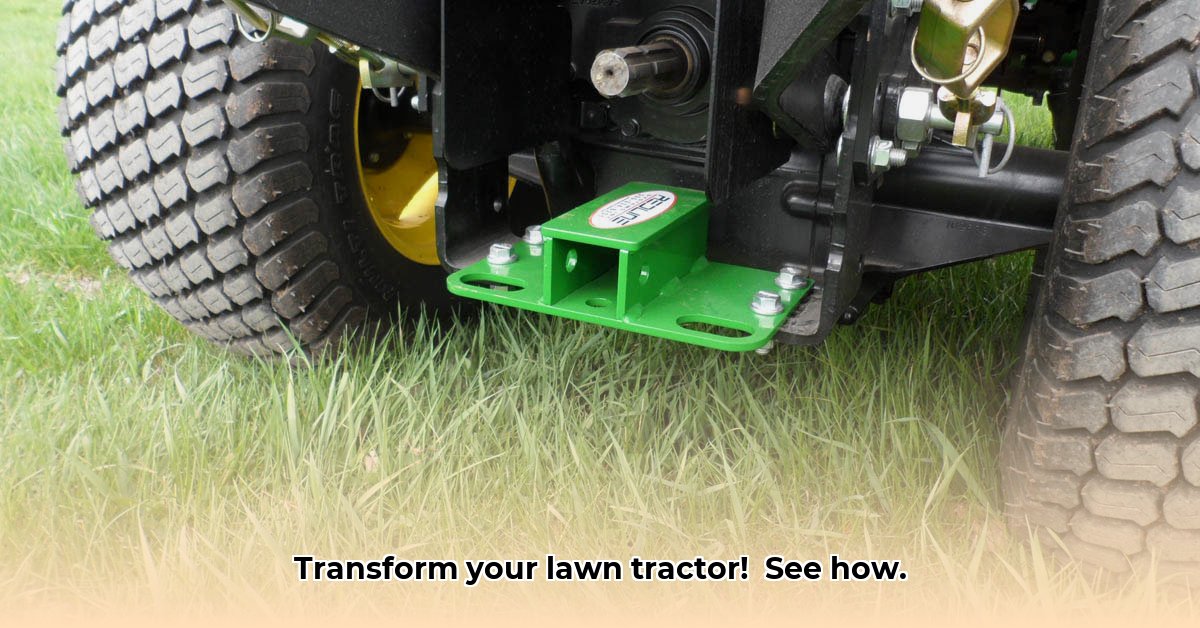
Understanding John Deere Lawn Tractor Hitches: Expanding Functionality
Your John Deere lawn tractor is a powerful tool, but its potential extends far beyond mowing. Adding a hitch transforms it into a versatile machine capable of tackling a wide range of tasks, significantly boosting efficiency and contributing to sustainable landscaping and small-scale farming practices. This guide provides a comprehensive overview of selecting, installing, and maintaining a hitch, maximizing its benefits for both efficiency and environmental responsibility. We'll cover everything from choosing the right hitch for your model to troubleshooting common issues and analyzing the cost-effectiveness of this upgrade. For more John Deere accessories, check out this helpful resource.
Types of Hitches for John Deere Lawn Tractors
John Deere lawn tractors utilize primarily two hitch categories: Category 0 and Category 1. Category 0 hitches are smaller and lighter, suitable for lighter-duty tasks and smaller tractors; Category 1 hitches are larger, more robust, and designed for heavier workloads and larger tractor models. Crucially, hitch compatibility depends entirely on your specific John Deere model. Always consult your owner's manual to determine the correct hitch type and ensure compatibility. Failing to do so could result in damage to your tractor or even personal injury. Diagrammatic representations of each hitch type would be helpful here, illustrating differences in size and mounting points. (Illustrations needed)
Selecting the Right Hitch: A Step-by-Step Guide
Choosing the correct hitch is vital for both safety and efficiency. Follow this step-by-step process:
Assess Your Needs: Identify the tasks you want your tractor to perform. Will you be using a light spreader or a heavy snow plow? The weight capacity dramatically impacts hitch selection.
Review Your Tractor's Specifications: Your tractor's owner's manual specifies the maximum weight capacity for the hitch. Never exceed this limit. Overloading the hitch is extremely dangerous and can cause severe damage.
Establish Your Budget: Hitch prices range considerably, so defining your budget helps avoid impulse purchases.
Explore Customer Reviews: Online reviews often reveal potential issues not mentioned in marketing materials.
Verify Installation Instructions: Carefully review the manufacturer’s installation instructions before purchasing. Ensure you possess the necessary tools and skills for installation, or consider professional installation.
Sustainable Attachments Compatible with Your John Deere Hitch
A hitch system unlocks the potential for several sustainable attachments:
Mulching Kits: Chop grass clippings into fine pieces, returning them to the lawn as natural fertilizer, reducing waste and the need for chemical fertilizers.
Bagging Systems: Collect clippings for composting, promoting soil fertility and reducing waste going to landfills.
Aerators: Improve soil aeration and water penetration, leading to a healthier lawn and reduced need for chemical treatments.
Snow Plows: Efficiently clear snow, making your tractor a more valuable asset year-round.
These attachments are key to environmentally friendly and efficient landscaping or small-scale farming.
Installation, Usage, and Maintenance: A Comprehensive Guide
Safe installation is paramount. Follow these steps:
Precise Alignment: Carefully align the hitch with your tractor's mounting points. Improper alignment can lead to instability and potential damage.
Secure Fastening: Use the supplied hardware to firmly attach the hitch. Double-check all connections are secure before operating.
Functional Testing: Gently raise and lower the hitch to confirm correct operation before attaching any implements.
Regular maintenance is crucial. Periodically inspect for loose bolts, worn parts, and lubricate moving components as recommended by the manufacturer. Always engage the parking brake before attaching or detaching any implements.
Case Study: A Sustainable Farming Approach
"Using a hitch and various attachments on my John Deere tractor has completely revolutionized my small-scale farming operation," said Sarah Miller, owner of Willow Creek Farm in Iowa. "I can now aerate my fields, spread my compost, and transport my produce much more efficiently and far more sustainably than when I relied on manual labor and separate machinery."
Cost-Benefit Analysis: The Long-Term Investment
While the initial investment in a hitch and attachments can seem high, the cost savings over time are significant. Avoiding purchasing individual machines for each task represents substantial savings, both financially and in terms of storage space. Moreover, the time saved with a multi-functional tractor often translates to increased productivity.
Troubleshooting and Problem Solving
Even with proper maintenance, issues might arise. Common problems include loose attachments (check and tighten fasteners), hitch malfunctions (consult your manual or John Deere support), and hydraulic issues (seek professional help).
Conclusion: Enhancing Efficiency and Sustainability
Adding a hitch to your John Deere lawn tractor unlocks a new level of versatility and efficiency. By embracing this system and the numerous compatible attachments, you can optimize your land management, reduce your environmental impact, and achieve long-term cost savings. Remember to always prioritize safety and consult your owner's manual for specific instructions and precautions.